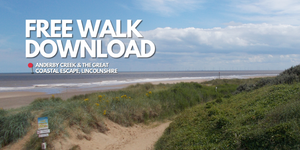5 of the best autumn walks in Norfolk – with a FREE downloadable walk

Looking for the best autumn walks in Norfolk? Look no further. Here we’ve rounded up a selection of our favourite routes in the county - walks chosen specifically to make the most of beautiful colours, ramble-friendly temperatures and crisp sea air...
All of these walks originally appeared in our Norfolk Year Round Walks book. The first walk you come to below, around Overstrand and Cromer, appears exactly as it does in the book, complete with map, pictures and step-by-step directions.
📥 You can even click here to download a PDF version, which you can print or take with you on your phone.
Below that are a number of further recommendations for places to get out for a walk in Norfolk this autumn.
Overstrand & Cromer (3¾ miles)
Although Norfolk is renowned for its flatness, there are a few places where contours trouble the map. One such area is the north-east coast between Overstrand and Cromer, where cliffs of soft clay reach a heady 75 yards in height. This walk, out along the beach and back along the escarpment, enables you to admire the cliffs (while they still exist) and to use the height to look far out to sea.

The route also takes in the best bits of Cromer, a Victorian seaside town that is enjoying rebirth as a foodie Mecca thanks to the clustering of fine independent eateries. Cromer is also renowned for its pier (particularly if you enjoy traditional seaside entertainment).
- How to get there & parking: Entering Cromer from the south along the A140, turn right onto Cromwell Road. Head straight over at the double roundabout, following signs to Overstrand. Continue broadly south-east, past the Royal Cromer Golf Club on your left (north). When you reach Overstrand, turn first left (north) into Pauls Lane, and follow this to the car park at the cliff top.
- Sat Nav: NR27 0PF
- Refreshments: In Overstrand, Cliff Top Café is just 100 yards from the car park, on Cliff Road. In Cromer, arguably the best fish and chips is served by Number 1 Cromer on New Street, which is run by local celebrity chef Galton Blackiston.
The Walk

1. From the clifftop car park, follow the sign for Paston Way east. Just after an open area with benches, a steep concrete path drops left (north) to the beach. Unless you want a cuppa at the Cliff Top Café (which lies just to your right) first, descend the path to reach the beach.
2. At the foot of the cliffs, turn left and walk for about 2 miles (3.2 km) west north-west along the beach to Cromer. This follows the National Trail. For the first few hundred yards, a wooden groyne runs parallel to the cliff, before seeming to abandon hope below some of the steepest cliffs and stuttering to an end. Other groynes stride into the sea, perpendicular to the cliffs. The slumping cliffs become increasingly vegetated as you approach Cromer, with sycamores and sea buckthorn among the plants helping stabilise the slope. Ahead of you is Cromer pier.
3. As you reach a line of beach huts, you leave the sandy ground to join a paved walkway. Continue along this, past the beach huts, until you reach the first fishing boats, which mark the start of the esplanade proper. Between here and Cromer pier is the RNLI museum (which houses the Rocket House Café) and various cafés and watersports establishments.
4. Feel free to stroll along the pier, which was built in 1900 to replace one destroyed in storms five years earlier. You could even go crabbing! Then walk up the zigzag path at the base of the pier to reach the town centre. At the top, a sign indicates that you are at the start of the Weavers’ Way, a long-distance footpath that features in another walk in this book (page 21). Turn left past Hotel de Paris then bear right onto Jetty Street, which features terraced houses of different colours. At St Peter and Paul’s Church, turn left along East Cliff, past a taxi rank. Beyond the Red Lion restaurant, take Brunswick Terrace (a narrow path with railings on either side) which curves to the right, overlooking the RNLI museum.
5. Cross the cobbled gangway and continue straight, following the footpath east as it weaves past a cottage and small park. On your right is a memorial bust in honour of lifeboatman Henry Blogg. The paved path rises gently until the National Trail (marked with acorn signs) is signposted left down to the beach; ignore this and continue straight along the clifftop, with its commanding views. Head past a seating area with benches and coastguard lookout, subsequently passing (or exploring, as you fancy) Warren Woods and Happy Valley.
6. Ignore public footpaths off to your right (south) and continue along the head of the cliffs. The path undulates considerably as it weaves through gorse and bramble. Cromer Lighthouse, set back to your right (south), signals the start of the Royal Cromer Golf Club, which you follow for all bar the final few hundred yards of the walk. Ensure that you tread a fine line by staying on the public footpath for the full 1¼ miles (2 km), neither venturing too close to the crumbling edge nor onto the golf course.
7. The path passes some houses on the right, which mark the start of Overstrand. After a rectangular green area, you duck through a belt of trees to emerge in the car park, a flagpole and playground to your right.

4 more autumn walks in Norfolk
Cley & Salthouse (4¾ miles)
Perhaps no part of Norfolk better symbolises the tug of war between man and nature than the stretch of coast between the postcard-perfect village of Cley next the Sea and neighbouring Salthouse. Twice in recent years a raging North Sea has invaded the land, enabling seals to swim along the A149, the main road that lies the best part of a mile from the normal shoreline.

This walk treads over shingle, traverses reedbeds, pauses at lagoons amidst rough grassland and rambles through damp woodland. There should be plenty of fauna and flora to see along the route. Brent and pinkfooted geese graze in the fields. Sea aster and yellow horned poppy may flower even as late as October – the former along the shingle, the latter by the saltmarsh. In the reedbeds of Cley Marshes reserve bearded tits can be prominent in autumn as family parties bounce around excitedly. The willow-rich scrub at Walsey Hills is often a favoured haunt of birdwatchers on the lookout for a Siberian warbler or two.
Holkham & Burnham Overy Dunes (6 miles)
Gwyneth Paltrow strode across its salted-caramel vastness at the close of the film Shakespeare in Love. Leading travel writers recently voted its unspoilt magnificence the best beach in Britain.

Topped by Norfolk’s famed big blue skies, Holkham Beach is genuinely jaw-dropping. Yet the expansive, liberating strand is just one highlight of this walk through a National Nature Reserve that encompasses grazing marshes thronged with wild geese, clandestine woodland dominated by a triumvirate of towering pines, swirling dune-heath harbouring natterjack toads, and muddy saltmarsh soothing tidal ravages.
Brancaster (4 miles)
The remnants of a Roman fort, an expansive bay beloved of kitesurfers, the breeziest of royal golf courses, a flint-rich village and Norfolk’s wildest saltmarshes make for a perfect autumn walk. While there is no longer anything to see of the Roman outpost of Branodunum, that is no excuse for not imagining the vivacity of its past. Brancaster is north-west Norfolk at its best.

Horsey (3½ miles)
The star of this walk amidst sand dunes, through grazing marshes and beneath a sentinel windmill is unequivocal. We are within a common crane’s bugle of one of Norfolk’s most famous broads. The colony of grey seals in the dunes at Horsey has rapidly become one of the country’s biggest, with more than 1,500 pups born each year. In 2017, an astonishing 1,818 chubby cuties greeted the world. How many will you count on your visit?

The common cranes – the birds rather than the machines – are harder to spot than the seals. A population of 60-odd individuals has made the vicinity their home for several decades, but they tend to lope amidst the highest vegetation around, making them tricky to see. No such problems of visibility when they take to the air, however. With long wings flapped majestically and neck and legs extended, their elegance is unparalleled. Seeing one (or, better, a flock) calls for a celebration. Just as well that one of Norfolk’s cosiest and foodiest pubs is just yards from the route…
- Rory Batho







Comments 0